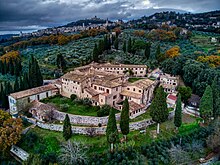Poor Clares
St. Francis believed that women, as well as men, had the capacity to completely forgo ordinary pleasures and live in poverty and did not seek to limit them in this regard based on their gender.[4] Clare's determination that her order not be wealthy or own property, and that the nuns live entirely from alms given by local people, was initially protected by the papal bull Privilegium paupertatis, issued by Pope Innocent III.The movement quickly spread, though in a somewhat disorganized fashion, with several monasteries of women devoted to the Franciscan ideal springing up elsewhere in Northern Italy.At this point Ugolino, Cardinal Bishop of Ostia (the future Pope Gregory IX), was given the task of overseeing all such monasteries and preparing a formal Monastic Rule.[5] Ugolino's Rule, originally based on the Benedictine one, was amended in 1263 by Pope Urban IV to allow for the communal ownership of property, and was adopted by a growing number of monasteries across Europe.On 9 August 1253, she managed to obtain a papal bull, Solet annuere, establishing a rule of her own, more closely following that of the friars, which forbade the possession of property either individually or as a community.The spread of the order began in 1218 when a monastery was founded in Perugia; new foundations quickly followed in Florence, Venice, Mantua, and Padua.The order then expanded to Belgium and France, where a monastery was founded at Reims in 1229, followed by Montpellier, Cahors, Bordeaux, Metz, and Besançon.[11] Due to the extreme loss of life from both sickness and war, many religious communities were forced to rebuild and recruit more people to the order.For example, prior to both The Hundred Years’ War and the Black Plague in 1330, The Poor Clares had around 80 women who were a part of the order in Toulouse, France.[13] In medieval England, where the nuns were known as "minoresses", their principal monastery was located near Aldgate, known as the Abbey of the Order of St Clare.After the dissolution of the monasteries under King Henry VIII, several religious communities formed in continental Europe for English Catholics.Following Catholic emancipation in the first half of the 19th century, other Poor Clares came to the United Kingdom,[16] eventually establishing communities in, e.g., Notting Hill (1857, which was forced to relocate by the local council in the 1960s, and settled in the village of Arkley in 1969),[17] Woodchester (1860–2011), Levenshulme (1863),[18] Much Birch (1880), Arundel (1886), Lynton (founded from Rennes, France, 1904–2010s), Woodford Green (1920–1969), York (1865–2015)[19] and Nottingham (1927–2023).In 1996, the community refocused on a ministry of social work and prayer, and moved to a smaller, modern home at Abigail Close, Wardown Park.Unable to make the high rent, they were forced to leave after eighteen short months and moved to a town called Nieuport, which was just further up the coast close to Ostend.[27] They separated into groups of two to avoid attention, and the young Abbess Cisly went to her father’s estate and found a piece of land that was away from the public.From that point on, persecution under the Penal Laws and war led to repeated destruction of their monastery and scattering of the community over two centuries, until 1825, when fifteen nuns were able to re-establish monastic life permanently on the site.A small group of Colettine nuns arrived from Düsseldorf, Germany, seeking a refuge for the community which had been expelled from their monastery by the government policies of the Kulturkampf.At the urging of Mary Ignatius Hayes in 1875 Pope Pius IX had already authorized the sending of nuns to establish a monastery of Poor Clares of the Primitive Observance from San Damiano in Assisi.After the reluctance on the part of many bishops to accept them, due to their reliance upon donations for their maintenance, a community was finally established in Omaha, Nebraska, in 1878.These French Clarissians were expelled from the Ottoman Empire at the onset of World War I; the communities were subsequently reestablished in 1949 amid the creation of Israel.The Poor Clare in the Philippines was led by Jeronima of the Assumption who was authorized by the King of Spain and the Minister General of the Order of Friars Minor to go there to found a monastery.They heightened their witnessing of the "privilege of poverty" of Clare by not having a permanent income but rather opened their gates of the Divine Providence through alms and the generosity of the people.For the meantime, they were sheltered at the Minor Seminary of the Franciscans in San Francisco del Monte, Quezon City for 5 years.The country has 27 monasteries in total: Sariaya Quezon (1957); Calbayog, Samar (1965); Betis and Guagua, Pampanga (1968); Cabuyao, Laguna and Tayud, Cebu (1975): Maria, Siquijor and Isabela, Basilan in (1986); Josefina, Zamboanga del Sur, (1989); Kidapawan, North Cotabato, Balanga Bataan, Lopez (Quezon Province), and Cabid-an, Sorsogon (1990); Guibang, Isabela, Mondragon, Northern Samar and Naval, Biliran (1991); Iguig, Tuguegarao (1992); Bolinao, Pangasinan and Cantilan, Surigao del Sur (1993); Boac, Marinduque and Polomolok, South Cotabato (1998); Aritao, Nueva Vizcaya (1999); Tabon-tabon, Albay and San Jose, Antique (2004); Borongan, Eastern Samar and Malasiqui Pangasinan (2011) and Tabuk, Kalinga (2017).Furthermore, their expansion does not only limit in the Philippine archipelago but also helped the aging communities in Tahiti, France, Italy, England, Germany, Egypt, USA.




DamianistsThe Poor Clare (short story)Poor Clare (novel)Saint ClareSan Damiano, Assisienclosed orderRoman Catholic ChurchFranciscanFrancis of AssisiClare of AssisiPalm SundayOrder of Friars MinorThird OrderRule of St. ClareInnocent IVConstitutionsColettine Poor ClaresCapuchin Poor ClaresPoor Clares of Perpetual AdorationazulejoConvent of LouriçalPortugalAssisiAssisi CathedralPortiunculaBenedictineSan DamianoabbessFlorencePope Innocent IIIPope Gregory IXMonastic RulePerugiaEuropepapal bullforbade the possession of property either individually or as a communityColette of CorbieAlcantarinesHoly SeeVeniceMantuaAgnes of AssisiBarcelonaBurgosBelgiumFranceMontpellierCahorsBordeauxBesançonMarseillesQueen MargaretKing Philip IVQueen JoanNewcastle upon TyneAldgateAbbey of the Order of St ClareMinoriesCity of Londondissolution of the monasteriesHenry VIIIcontinental EuropeEnglishPoor Clare monasteryGravelinesMary WardFrench Revolutionary ArmyEnglandDarlingtonCatholic emancipationUnited KingdomNotting HillArkleyWoodchesterLevenshulmeMuch BirchArundelLyntonRennesWoodford GreenNottinghamIrelandGalwayTheobald Dillon, 1st Viscount DillonIrish womenDublinCisly DillonPenal LawsCarlowenclosedDrumshanboSecond OrderFaughartCounty LouthCologne CathedralBrugesEindhovenNetherlandsLarvikNorwayHungaryLithuaniaPolandBambergBratislavaBrixenNurembergMünsterGermanySigolsheimConvent of Saint ClareSt. Clare's Priory, StockholmRevolutionary FranceDüsseldorfKulturkampfDiocese of ClevelandMary Ignatius HayesPope Pius IXNebraskaAlexandria, VirginiaAndover, MassachusettsBelleville, IllinoisBordentown, New JerseyBoston, MassachusettsBrenham, TexasChicago, Illinois

